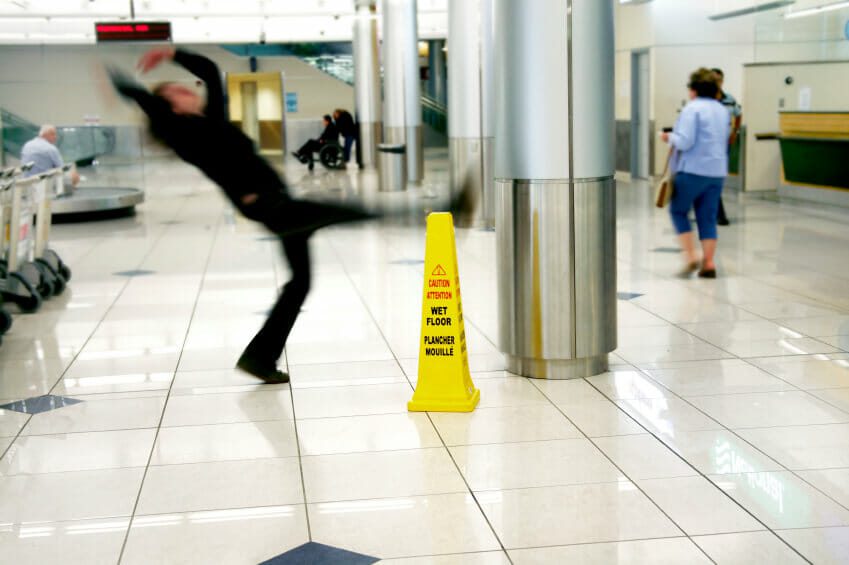How is Fault Proven in a Slip and Fall Accident?

Slip and fall accidents are one of the most common cases that fall under the category of premises liability. Often used as a comedic element on television or movies, slipping and falling is no laughing matter in reality. A slip and fall can result in catastrophic injuries, including broken bones, back injuries, neck injuries, spinal cord damage, and even traumatic brain injuries.
These incidents can be caused by a variety of factors, such as a spilled liquid on the floor, cracked sidewalks, damaged stairways, icy walkways, objects on or protruding from the ground, or poor lighting. However, simply because one of these factors led to a slip and fall accident does not necessarily mean that the property owner will be held liable.
In order to hold a property or business owner liable, a plaintiff’s legal team must be able to prove that:
- The property owner created or contributed to the factor that caused the slip and fall;
- The property owner knew that the factor existed and did not take reasonable care to fix or correct the issue; or
- The factor that caused the slip and fall was present for a period of time in which the property owner should have been discovered or been aware of it and should have fixed it
The factor or condition must present an unreasonable risk to people on the property, one that could not have been anticipated to cause an accident.
For example, if a spilled liquid is marked with a caution sign warning visitors of a slippery floor and someone slips and falls, there was a clear danger and adequate warnings for visitors. In this case, it will be hard to establish that the property or business owner was negligent since the hazard was clearly (and reasonably) marked with a warning.
However, if a spilled liquid was brought to the attention of the business several times, and the spill was not addressed in a timely manner (either cleaned up or marked with a warning sign), it will be easier to determine that the property owner’s negligence led to a slip and fall victim’s injuries. In this example, if a previously known condition such as a leaky pipe contributed to the liquid on the floor and the property or business owner failed to correct it, this may also prove that they acted negligently.
Liability largely relies on whether the steps a property or business owner took to address a dangerous condition were reasonable or not. In slip and fall accidents and many other premises liability cases, it is often up to a judge or jury to determine if the property owner, business owner, or landlord failed to adhere to a reasonable standard of care for the unique situation at hand.
What if I am Partially at Fault for the Slip and Fall Accident?
Oftentimes in a slip and fall case, the property owner will concoct a legal defense and try to avoid liability by claiming that the slip and fall (and subsequent injury) was the victim’s fault. This defense is raised by the defense counsel in which they must prove that the injured party contributed in some way to the accident.
There are different types of comparative fault and negligence systems depending on the state in which you reside. In Texas, for example, a modified comparative fault system allows plaintiffs to recover damages as long as they are found to be no more than 50 percent negligent in the accident that caused their injury. However, if a jury awards a plaintiff that is found to be partially at fault for the accident, the recoverable damages are reduced by that percentage. For example, a jury award of $100,000 would be reduced to $50,000 if a plaintiff is found to be 50 percent at fault.
Learn more about comparative fault and contributory negligence in our blog post: What if I am partially to blame for my injuries caused by another person?
Where do Slip and Fall Accidents Commonly Occur?
Slip and fall accidents can occur in a variety of settings: indoors or outdoors, residential or commercial. A landlord of a residential property can be held liable for an injury sustained in a slip and fall just as a property or business owner could. A serious slip and fall accident commonly occur in the following locations:
- Amusement parks
- Apartment complexes or buildings
- Elevators
- Grocery stores
- Parking garages
- Parking lots
- Restaurants and bars
- Retail stores
- Shopping malls
- Sidewalks and other walkways
- Sports stadiums and arenas
- Stairways
To learn more about slip and fall accidents, check out our blog post: Should I report my injury to the property manager if I was injured in a slip and fall?
Contact an Experienced Premises Liability Attorney
If you were injured in a slip and fall at a business or residential property, contact Thomas J. Henry. Our law firm has more than 25 years of experience handling premises liability cases, including slip and fall accidents, where victims have suffered serious injuries due to an unsafe property. If a property owner, business owner, or landlord failed to maintain a reasonably safe conditions on their property, you may be entitled to compensation for the injuries you have sustained. Attorneys are available 24/7, nights and weekends to evaluate your claim and provide you with a free legal consultation.

